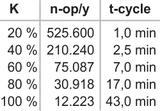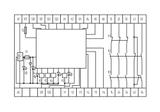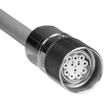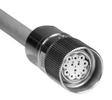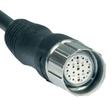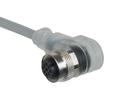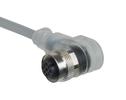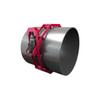- Level 1: Reset without edge detection, Optional Automatic reset function, Short-circuit recognition, Level 2: / Opener (NC) Normally open contact (NO)
- Multifunctional safety relay module for superior diagnostics and visualisation
- Suitable for the signal processing of outputs with contact sensors
- Suitable for signal processing of outputs connected to potentials (AOPDs), e.g. safety light grids/curtains
- Suitable for the signal processing of outputs with contact sensors
- 3 safety contacts, STOP 0
- 2 + 6 Signalling outputs
Ordering data
| Note (Delivery capacity) | Not available! |
| Product type description | SRB308IT-24VAC/DC |
| Article number (order number) | 101158200 |
| EAN (European Article Number) | 4250116201556 |
| eCl@ss number, Version 9.0 | 27-37-18-19 |
| eCl@ss number, Version 11.0 | 27-37-18-19 |
| ETIM number, version 6.0 | EC001449 |
| Replacement article number | 101159511 |
Approval - Standards
| Certificates | cULus EAC |
General data
| Standards | IEC 61508 IEC/EN 60204-1 EN 60947-5-1 EN ISO 13849-1 |
| Climatic stress | EN 60068-2-78 |
| Enclosure material | Glass-fibre reinforced thermoplastic, ventilated |
| Material of the contacts, electrical | AgSn0, Ag-Ni, self-cleaning, positive drive |
| Gross weight | 480 g |
General data - Features
| Stop-Category | 0 |
| Electronic Fuse | Yes |
| Wire breakage detection | Yes |
| Short-circuit recognition | Yes |
| Removable Terminals | Yes |
| Start input | Yes |
| Feedback circuit | Yes |
| Automatic reset function | Yes |
| Reset edge detection | Yes |
| Earth connection detection | Yes |
| Integral System Diagnostics, status | Yes |
| Number of auxiliary contacts | 2 |
| Number of LEDs | 5 |
| Number of openers | 2 |
| Number of undelayed semi-conductor outputs with signaling function | 6 |
| Number of safety contacts | 3 |
| Number of signalling outputs | 6 |
Safety appraisal
| Standards | EN 60947-5-1 IEC 61508 |
| Mission Time | 20 Year(s) |
| Common Cause Failure (CCF), minimum | 65 |
Safety appraisal - Relay outputs
| Performance level, stop 0, up to | e |
| Category, Stop 0 | 4 |
| Diagnostic Coverage (DC) Level, Stop 0 | ≥ 99 % |
| PFH-Value Stop 0 | 2.00 x 10⁻⁸ /h |
| Safety Integrity Level (SIL), Stop 0, suitable for applications in | 3 |
Mechanical data
| Mechanical life, minimum | 10,000,000 Operations |
| Mounting | Snaps onto standard DIN rail to EN 60715 |
Mechanical data - Connection technique
| Terminal Connector | Screw connection rigid or flexible |
| Terminal designations | IEC/EN 60947-1 |
| Cable section, minimum | 0.25 mm² |
| Cable section, maximum | 2.5 mm² |
| Tightening torque of Clips | 0.6 Nm |
Mechanical data - Dimensions
| Width | 45 mm |
| Height | 100 mm |
| Depth | 121 mm |
Ambient conditions
| Degree of protection of the enclosure | IP40 |
| Degree of protection of the mounting space | IP54 |
| Degree of protection of clips or terminals | IP20 |
| Ambient temperature, minimum | -25 °C |
| Ambient temperature, maximum | +45 °C |
| Storage and transport temperature, minimum | -40 °C |
| Storage and transport temperature, maximum | +85 °C |
| Resistance to vibrations to EN 60068-2-6 | 10 ... 55 Hz, Amplitude 0.35 mm |
| Restistance to shock | 30 g / 11 ms |
Ambient conditions - Insulation value
| Rated impulse withstand voltage Uimp | 4 kV |
| Overvoltage category | III |
| Degree of pollution to VDE 0110 | 2 |
Electrical data
| Frequency range | 50 Hz 60 Hz |
| Rated operating voltage | 24 VAC -15% / +10% 24 VDC -15% / +20%, residual ripple max. 10 % |
| Operating current | 125 mA |
| Rated AC voltage for controls, 50 Hz, minimum | 20.4 VAC |
| Rated control voltage at AC 50 Hz, maximum | 26.4 VAC |
| Rated AC voltage for controls, 60 Hz, minimum | 20.4 VAC |
| Rated control voltage at AC 60 Hz, maximum | 26.4 VAC |
| Rated AC voltage for controls at DC minimum | 20.4 VDC |
| Rated control voltage at DC, maximum | 28.8 VDC |
| Utilisation category AC-15 | 230 VAC |
| Utilisation category AC-15 | 1.5 A |
| Utilisation category DC-13 | 24 VDC |
| Utilisation category DC-13 | 1.2 A |
| Electrical power consumption | 3 W |
| Electrical power consumption | 3 VA |
| Contact resistance, maximum | 0.1 Ω |
| Note (Contact resistance) | in new state |
| Drop-out delay in case of emergency stop, maximum | 15 ms |
| Pull-in delay at automatic start, maximum, typically | 60 ms |
| Pull-in delay at RESET, typically | 200 ms |
Electrical data - Digital inputs
| Conduction resistance, maximum | 40 Ω |
Electrical data - Electromagnetic compatibility (EMC)
| EMC rating | EMC-Directive |
Status indication
| Indicated operating states | Position relay K2 Position relay K1 Internal operating voltage Ui Position relay K3 |
Other data
| Note (applications) | Guard system Pull-wire emergency stop switches Safety light curtain Emergency stop button |
Notes
| Note (General) | Inductive loads (e.g. contactors, relays, etc.) are to be suppressed by means of a suitable circuit. |
Circuit example
| Note (Wiring diagram) | The wiring diagram is shown with guard doors closed and in de-energised condition. The ISD tables (Intergral System Diagnostics) for analysis of the fault indications and their causes are shown in the appendix. Relay outputs: Suitable for 2 channel control, for increase in capacity or number of contacts by means of contactors or relays with positive-guided contacts. The control recognises cross-short, cable break and earth leakages in the monitoring circuit. Connect potential p-type outputs of safety light grids/curtains to S12/S22. The devices must have the same reference potential. 2 channel control shown for a guard-door monitor with two contacts, of which at least one contact has positive break, with external reset button (R) and feedback circuit (H2). (example without cross-wire monitoring) For 2-channel control with cross-wire monitoring, connect the NC contact to S11/S12 and S31/S32 and bridge S21/S22 For 1-channel control, connect NC contact to S11/S12 and bridge S21/S22 and S31/S32 'Start function / Reset button: The function 'trailing edge' is programmed by means of the 'AF' switch located underneath the housing cover (switch position = 1). The automatic start is programmed by bridging terminals X3/X5 and by switching the 'AF' switch to 0. The time offset between the channels is approx. 100 ms. An endless time offset between the channels 1 and 2 is programmed by bridging the terminals X3/X6.' F1 = Hybrid fuse F2 = Fuse for signalling outputs |


